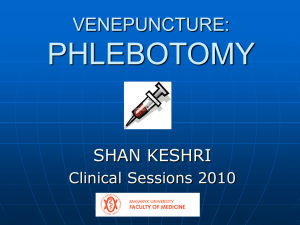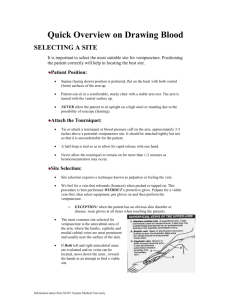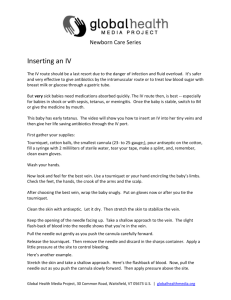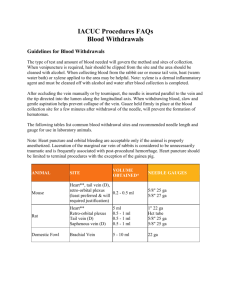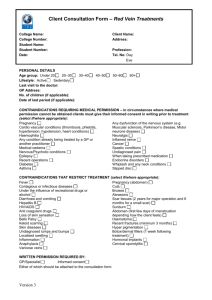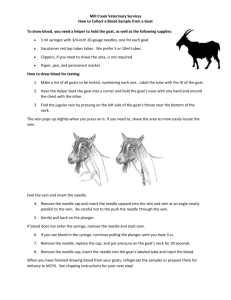Blood Collection Tubes
advertisement
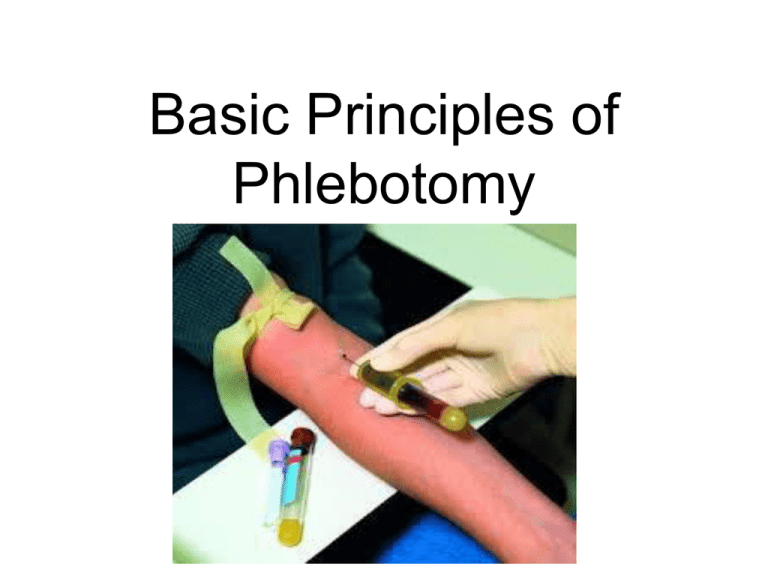
Basic Principles of Phlebotomy Congratulations Mercedes!! Skills USA 1st Texas Championship Nurse Assisting 2 Phlebotomy Video 3 Blood Composition: Formed elements (~45%) – RBC – WBC – Platelets Fluid component (~55%) – Water (~92%) – Protein (~7%) – etc 4 Blood Collection Tubes: • Contain a vacuum • Used with Vacutainer and Syringe systems • Stoppers universal color coded: indicates contents • Have an expiration date 5 Safety: Engineering Controls • PPE • Sharps containers • Safer medical devices 6 Safer Medical Devices: 7 Equipment: 1. PPE: gloves, lab coat, mask 2. Cleaning agent – Alcohol pads: routine – Povidone iodine: blood culture collection and blood gases – Soap and water: alcohol testing, allergies 3. Cotton balls, gauze 8 Equipment: 4. Bandage, tape (use caution with children) 5. Sharps container: – Discard needles, lancets – Biohazard marking – Puncture resistant – NEVER recap, bend break needles 9 Equipment: 6. Tourniquets: – – – – Slows venous blood flow down Causes veins to become more prominent NEVER leave on for >1 minute AVOID rigorous fist clenching or hand pumping (potassium, lactic acid, LD) – Latex allergy 10 Tying on the Tourniquet: 11 Equipment: 7. Needles – – – NEVER reuse a needle NEVER use if shield is broken NEVER recap, cut, bend or break – Drop immediately into sharps container after venipuncture – Size of needle is indicated by gauge: • • Larger gauge number indicates smaller needle diameter 21, 23 gauge needles routinely used for phlebotomy 12 Needles: Used with syringe system Used with vacutainer system13 Multi-sample Needle: 14 Butterfly Needle: 15 Butterfly Needle: • Most often used with syringe • Expensive, thus not used for routine draws • Used for small, fragile veins • Increased risk of needle stick injury 16 Equipment: 8. Tube holder/ vacutainer adapter – Threaded – Flanges 17 Equipment: 9. Syringe 10. Black water proof pen 18 Syringe Safety Device: 19 Labeling Blood Collection Tubes: • Black indelible marker (water proof) – Never pencil – Legal document – Print legibly • Required information: 5 items – – – – – Patient name Identification number Date of draw (mm,dd,yyyy) Time of draw (military time) Phlebotomist initals 20 Labeling Last Name, First Name Patient ID: 1234-56 June 5, 2005 8:10 AM Initials: SM 21 Vacutainer or Syringe? • Vacutainer – Most often used – Most economical – Quick – Least risk of accidental needle stick • Syringe – More control – Reposition easily – Will see ‘flash’ of blood in syringe hub when vein successfully entered 22 The Patient: • • • • • Approach Communication Empathy Handling special situations Patient identification – Arm band – Legal document • Prepare patient for blood draw – Latex allergy? 23 Great QUESTIONS TO ASK YOUR PATIENT • Have you ever had blood drawn before? • Have you had problems during a venipuncture? • If yes— – Did you have pain, bruising or bleeding? – Did you have chest pain, dizziness, fainting or nausea? 24 Necessary Equipment for Venipuncture Equipment • • • • • PPE Alcohol swabs Gauze pads Tourniquet Needles- sterile disposable • Blood collection tubes • Pediatric collection tubes Equipment • Winged infusion sets • Vacutainer • Lancets 25 Patient Preparation 1. Patient education 1. Do not make it lengthy 2. Tell the steps of the procedure 3. Instruct patient to let you know right away if they are having pain 4. Explain possible complications 1. Bruising, hematoma, infection, prolonged bleeding, excessive pain 5. Ask if they have questions 26 Selecting the Site 1. 2. 3. 4. Begins with hand washing Must be done before and after procedure Don gloves Ask patient to extend arm with palm facing up 5. Search for a vein using visual examination and palpation 27 Selecting the Site: • Antecubital area most often accessed – “ the bend of the arm” – Preferred site – There are 3 veins that are preferred for blood draw in this location 28 29 The 3 Preferred Veins • Medial Cubital – 1st choice – In center of AC fossa – Usually does not move – In obese patient- not seen by can be palpated • Cephalic Vein – 2nd choice – Located in lateral aspect of AC fossa – Large vein and can be seen – *** tends to ROLL and difficult to stabilize • Brachial Vein – Last choice – Located in medial aspect of AC fossa – ** very close to brachial artery – Not visible and tends ROLL 30 Examine the Patients AC FOSSA!! • If you see a good vein it is time to palpate! • Touch the vein with you fingers • Vein should feel – Soft – Flexible – Non- tender – The vein SHOULD NOT BE HARD, INFLEXIBLE OF TENDER 31 Conditions • The following conditions cause veins to be unsuitable for venipuncture – Sclerosis • HARD, INFLEXIBLE,NARROW – Tortuous veins • TWISTED, TURN EASILY – Thrombotic veins • BLOOD CLOT(S) IN THE VEIN – Fragile veins • THIN, DARK, CLOSE TO SURFACE, COLLAPSE EASILY – Phlebitis • INFLAMMED BLOOD VESSELS, TENDER TO TOUCH 32 Complications • If performed on any of the aforementioned categories – Vein will be difficult to access – Impossible to puncture – Painful – Easily damaged – Blood supply through the vein will be POOR 33 Troubleshooting to Locate a Vein • Place the arm below the level of the heart for several minutes • Place a warm compress • *** The best technique is to slow down and take your time • Ask someone else to try • Notify supervisor • Notify Physician 34 Other Veins • • • • Hand and wrist veins Dorsum area of the hand Easily seen--- *** are more fragile!! ** ROLL easily– superficial,small and painful • Short length– difficult to to angle needle • Vein on underside of wirst – CLOSE to Artery and Nerves – Physically challenging to access 35 Hand Vein Draw 36 NO BLOOD DRAW •On arm with IVF •Dialysis Shunt •Mastectomy side 37 Collection Site Problems: • Intravenous line – NEVER draw above an IV – Draw from other arm – Draw from hand on other arm – Draw below the IV 38 Draw Below IV site: 39 Cleaning the SITE • Invasive procedure • Scrub with isopropyl alcohol 70% • Other germicides include- chlorhexidine and iodine • Alcohol preferred – Dries fast – No residue – Not highly irritating – Does not obscure – Not drying to the skin 40 Proper Venipuncture Technique • • • • • • • • • Introduce self Identify the patient Check laboratory requisition form Have patient sit or lie down- NEVER STANDING Assemble equipment – check expiration Wash hands Don gloves Locate vein Apply tourniquet 41 STEPS • • • • • • Do not touch area after prepping site Use your fingers to spread the skin & make tight Uncap and inspect the needle tip Discard if defective or if sterility was compromised Insert the needle at 15-30 °angle – BEVEL UP This angle – Allow room to work – Reduces pushing the needle through the vein – Allow best blood flow 42 Needle Position: 43 44 Releasing the Tourniquet • Once the needle has entered the vein and you have attached the 1st tube to the infusion set or vacutainer • RELEASE the tourniquet • The tourniquet should NOT be left on for more than 1 minute 45 Complications of Leaving Tourniquet Applied Too Long 1. Hemolysis 1. Destruction of blood cell 2. Will cause abnormal electrolyte readings 2. Petechiae 1. Very tiny hemorrhages-appear in red and purple spot on the skin 3. Hemoconcentration 1. Tourniquet application can force fluids out of cells and leak into blood volume 46 Petechiae 47 Attach the Collection Tubes • After you have successful accessed the vein • Attach the blood collection tubes to vacutainer or infusion set • Tubes will fill in about 5 seconds • Tubes must be filled in the correct sequence • Tubes must be handled correction after filling • At most– if you fill 6 tubes with blood– 30 ml or cc’s will be the amount of blood removed 48 Order of the DRAW 1. 2. 3. 4. 5. 6. Blood cultures or sterile specimens Blue top Red top Gold or Green top Lavender or Purple top Gray top 49 Fill Tubes: • Use correct order of draw: – Sterile/Blood cultures-----------SALLY – Blue------------------------------------BRINGS – Red-------------------------------------REALLY – Gold/Green---------------------------GOOD GREASE »and – Purple/ Lavender-------------------LEAVES »the – Gray------------------------------------GRAVEY 50 Inverting the Tubes • Once filled– tubes must be inverted • Invert by holding it in your hand and turning your wrist • Blue top- 3-4 inversions • Lavender and Green top- 8-10 inversions • Serum separator tubes ( SST, red tops) and serum tubes ( red tops without the separating gel) 5 inversions 51 Removing the Needle • Place gauze over the needle • Quickly remove needle and apply firm pressure to site • Always use gauze pad and wear gloves • Allow patient to apply pressure ( if possible) so you can invert tubes • You can place pressure for 30 seconds and apply adhesive bandage over the gauzes 52 Recheck Draw Site: 53 Labeling the Tubes Immediately: • • • • • In sight of patient Patient name Identification number Date of draw Time of draw (military time) • Your initials • **This is a critical step • **Mislabeling can lead to serious consequences 54 Handling and Transporting Specimens • • • • • All specimens must be handled correctly Most have a standard # of inversions Most can be stored at room temp **** There are exceptions!!! Learn the proper transport policy of the facility 55 Finishing the Procedure • • • • Discard the needle in sharps container NEVER REUSE!!! NEVER RECAP!! Remove gloves and wash your hands!!! 56 Recheck Draw Site: 57 Reporting Test Results • There may be occasions in which you will be asked to transmit lab results • The keys to doing this accurately and correctly are repetition and confirmation 58 After the Venipuncture • • • • • • • Check the patient for: Excessive bleeding Excessive pain Lack of sensation Excessive bruising Signs of infection How the patient feels 59 Troubleshooting Technical Problems during Venipuncture • Most are done quickly and with ease • What do you do if the blood flow stops? – *** This occurs when the vacuum is not enough – ***Patency of the system has been compromised – Try another tube – check to see if you have released the tourniquet – Needle is in too far or not far enough 60 • • • • • • • • Collection Site Problems: Complications Nerve damage Hematomas Phlebitis Petechiae Thrombus Physical Reactions Collection or processing errors Edematous area 61 Collection or Processing • • • • • • Misidentification of patient Improper site selection and preparation Incorrect order of the draw Under filling of tubes Failure to invert tubes Failure to document when a specimen was obtained and when it was received • Mislabeling of the specimen 62 Needle Sticks and Contact with Body Fluids and Secretions • Good technique and PPE is KEY!! • If you have contact with skin– WASH Immediately with soap and water • EYE contact= Eye wash for 15 minutes with lukewarm water • Inhalation of body fluid=leave area and seek fresh air • ** Report exposure soon after you finish basic first aid measures 63 Needlesticks • • • • • Milk and wash the area with soap and water Cover with dressing Report the incident ASAP Any break in the skin can be a portal of entry!! Risk of HIV, Hepatitis B & C 64 First Aid, Medical Emergencies and the Phlebotomy You must be prepared to deal with medical emergencies • excessive bleeding- apply direct pressure & call for help • Patient faints-call for help – try to prevent patient injury- check for breathing and pulse • Know how and when to start CPR • Know who and what to do quickly 65 Finger and Heel Stick Phlebotomy • If blood is needed and venipuncture is contraindicated • Heel or finger stick may be used • These are NOT venipuncture- because you are not drawing from veins • You are drawing from capillaries • There are differences between a HEEL and FINGER sticks • 66 Capillary Blood • Mixture of arterial, venous, capillary blood and fluid from surrounding tissues • Fluid from surrounding tissues may interfere and/or contaminate the specimen • Warming skin puncture site increases arterial blood flow to the area • Reference ranges often differ from venous 67 Fingersticks • Done when only a small amount of blood is needed • When venous access is difficult • Commonly done on children • Commonly done on adults who need very frequent blood checks • Can be used to check for lead, hemoglobin and other blood components including blood glucose 68 Fingerstick Procedure • • • • • • • Infection control Assemble equipment AIDETPosition patient wash hands Don gloves ID site- middle and ring finger are best • Use side of the finger – Avoid cold, cyanotic, scarred, fingers • Clean site with alcohol 70% • Gently massage- milk finger puncture fingertip with lancet • Wipe away first drop • Allow blood to drip into collection tube • Cap when filled • Position and massage site as needed- careful not to over milk/massage may damage cells • Cap filled tube • Label specimen • Check patient • Discard equipment • Remove glove & wash hands 69 Heelstick Procedure • Assemble equipment • Choose correct lancetwill puncture the skin to a specific depth – If infant <2.2 lb. choose lancet which punctures depth of 0.65mm • Positon patient • Apply heel warmer for 35 minutes • Wash hands and don gloves • Select site – Best sites are lateral and medial sides of the heel – DO NOT USE back of heel – Clean site – Puncture skin with lancet – Use your thumb and fingers to gently squeeze heel – Wipe away first drop of blood – Allow blood to drip into collection tube – Do not over squeeze – Cap tube when filled – Label specimen – check patient – discard equipment – remove gloves & wash hands 70 Recheck Draw Site: 71 SPECIAL COLLECTIONS • This refers to any collection that is different from the standard blood draw • Uses techniques that are a bit more complicated • You may be required to perform or assist in a special collection 72 Peripheral Blood Smears • A peripheral blood smear is a blood collection that is used most often to diagnose a hematologic disorder • The smear is used to examine different types of white blood cells ---WBCs • This is call checking the DIFFERENTIAL • Peripheral blood smears also are used to detect malarial parasites in the blood 73 Peripheral Blood Smears • Can be done using capillary or venous blood • It can be collect at the bedside or using blood from an EDTA collection tube • You will need the following equipment: – Lens cleaner – Lens paper – glass slides – gloves – EDTA tube 74 Peripheral Smears • Take 2 glass slides • Apply drop of lens cleaner on each slide and use the lens paper to rub the slides until they are dry • Invert the EDTA tube 8-10 times • Open the stopper & use a stick or other pipette to remove a small amount of blood • Place a drop of blood 2mm in diameter onto the slide just in front of frosted area • Drop of blood should be in the center of the slide & approximately ¼ inch from the back edge of the slide • Smear immediately after the blood is applied** a delay will affect the test • Do this by using the end of the other slide, hold at 30° just in front of the blood and then pull the slide until it just touches the blood 75 Peripheral Smears • The blood will begin to spread towards the edge of the bottom slide • Wait until the blood has almost reached the edges of the bottom slide • Maintain a 30°- push the spreader slide rapidly across the bottom slide • Do not press down • The smear should be across ¾ of the bottom slide • There should be a smooth appearance and no holes or lines • It should have rainbow sheen when reflected in light • Allow smear to air dry and label correctly 76 How to Prepare a Peripheral Blood Smear Slide • Peripheral Blood Slide Preparation 77 Blood Culture Collection • Obtained to detect the presence of microorganisms in the blood= bacteremia • Blood Culture or Blood C & S requires a specific collection procedure 78 Blood Culture Collection • Assemble equipment • Blood Culture Bottles 2( anaerobic & aerobic) • Tourniquet • Gloves • Alcohol 70 % swabs • Gauze pads • Chlorhexidine • Syringe & winged infusion set • 79 Blood Culture Collection • Clean top of bottles with alcohol ( NOT with CHOLORHEXADINE OR IODINE allow to dry for 30 seconds • Find suitable site and clean with chlorhexidine -------scrubbing firmly a 5 cm area for 30 seconds • Allow to dry and DO NOT TOUCH the area once prepped • Perform venipuncture and remove 20 ml of blood using butterfly device with special BC vacutainer device • Transfer the blood to the bottles filling the aerobic 1st then the anaerobic bottle • Divide blood amounts evenly between the 2 bottles • *** it is helpful to mark off the fill level on the bottles for filling accuracy 80 Blood Culture Collection Procedure • Blood Culture Collection Procedure 81 Recheck Draw Site: 82 Blood Samples for Inborn Errors of Metabolism • Genetic disorders that affect the way the body metabolizes certain nutrients • Will affect the enzyme systems • Diagnosed by blood tests • 3 common blood tests are: 1. Serum Ammonia 2. Serum Lactate 3. Serum Pyruvate 83 Blood Samples for Inborn Errors of Metabolism • Use the standard venipuncture procedure • DO NOT use a tourniquet or have the patient make a fist • Patient should be fasting for the serum pyruvate level • These specimens are collected in special tubes • MUST BE PLACED ON ICE & immediately transported to the lab for processing 84 Phlebotomy for Blood Donation • Collecting specimens for blood donation follow the same principles • Patient ID • Patient assessment • Site preparation • Vein access • Infection control 85 Phlebotomy for Blood Donation • Screening for BLOOD donation includes: – Age – weight – Blood- borne disease exposure – ** Today guidelines are very specific and extensive – Maximum amount of blood that is taken is 525 ml – American Academy of Blood Banks recommendation is 10.5 ML per kg of body weight– assuming a minimum weight of 110 lb or 50 kg 86 Draw Below IV site: 87 No Needle Movement! • You must anchor the blood-drawing equipment on the patient’s arm to minimize chance of injury 88 89 Withdraw Needle: • First release tourniquet • Disengage tube • Place cotton directly over needle, without pressing down • Withdraw needle in swift, smooth motion • Immediately apply pressure to wound • Do not bend arm 90 You should try again • Look at alternate site – Other arm – Hand • Use clean needle • Use fresh syringe if contaminated • Only try twice 91 Venipuncture Procedure: • • • • • • Wash hands Put on gloves Identify patient Latex allergy? Position arm Apply tourniquet 92 Venipuncture Procedure: • Locate vein • Release tourniquet • Cleanse site in outward rotation – Allow to air dry 93 94 Mark your spot 95 Venipuncture Procedure: • Reapply tourniquet – Do not contaminate site • Anchor vein • Insert needle • Fill tubes – Quick mix additive tubes • Release tourniquet • Withdraw needle 96 Venipuncture Procedure: • Engage safety device • Dispose of needle immediately • Apply pressure to puncture site • Label tubes • Recheck puncture site • Thank patient • Remove gloves, wash hands 97 Syringe draw 98 Be careful not to: • Push needle further into vein when engaging evacuated tube • Pull needle out of vein when disengaging tube • Pull needle out of vein as you pull back on the plunger • Pull up or press down when needle in vein • Forget to mix additive tubes 8-10 times 99 Syringe Safety Transfer Device 100 Skin Puncture Procedure: 1. 2. 3. 4. 5. 6. 7. 8. 9. Wash hands Approaching the patient Patient identification Latex allergy? Bedside manner Site selection Cleanse site: DO NOT use providone- idodine Perform puncture: Wipe away first drop of blood Label the specimen 101 Skin Puncture: • Method of choice for infants, children under 1 year • Adults – Scarred – Fragile veins – Hardened veins – Home glucose monitoring (POCT) – Patients with IV 102 Skin Puncture Procedure: • Hold finger between your index finger and thumb • Puncture the finger using a quick, smooth motion • Wipe away the first drop of blood 103 Skin Puncture Site Selection: 104 Skin Puncture Equipment: 1. PPE 2. Cleaning agent – Alcohol pads: routine – Soap and water: alcohol testing, allergies – DO NOT use providone iodine 3. Cotton balls, gauze 105 Skin Puncture Equipment: 4. Bandage/tape 5. Sharps container 6. Warming device – – Commercial warmer Warm wet washcloth 106 Skin Puncture Equipment: 7. Lancet – Always use standardized equipment – NEVER use a surgical blade 107 Skin Puncture Equipment: 8. Micro-specimen containers – Capillary tubes – Microtainers – Capillary blood gas tubes – Micropipet diluting system 108 Skin Puncture Equipment: 9. Glass slides: used to prepare blood smears 109 Skin Puncture Procedure: • Collect sample – DO NOT touch collecting device to skin surface – DO NOT scrape collecting device across skin surface – DO NOT scoop blood into collecting device 110 Skin Puncture Procedure: • Order of draw is critical: platelets accumulate at puncture site causing clot formation – – – – Blood smear EDTA Heparin Serum • Apply pressure to puncture site • Label specimen in sight of patient (indelible marker) 111 112 113 114 Specimen Processing Essential Knowledge 115 Labeling and Transporting Specimens • Each facility has a protocol for transporting specimens – The time from collection to transport – Storage requirements for the specimen during transport – Most can be transported on room Air – Some require traveling on ice 116 CLIA Quality Control • Clinical Laboratory Improvement Amendments – Federal regulatory standards for labs that perform testing of human samples – CLIA standards stipulate that certain simple, low risk lab tests may be waived – There does not have to be any direct routine oversight of the labs in regards to how they perform these tests 117 Good Lab Practices • Include: – Using recent package insert from the kits manufacturer – Doing quality control or calibration on equipment – Documenting quality control – Storing and handling according to manufacturer – Provide personnel with training and document training – Using OSH regulations that pertain to labs 118 Non-Blood Specimen Collection Transport • Include; –Semen –Sputum –Stool –urine 119 Collection • All will require a simple collection • This means the patient is given a cup and the specimen is placed in the cup • The only exception is – Sterile urine 120 • • • • • • • • • Sterile Urine Collection Wait 2-3 hr. for urine to be in the bladder wash hands Men- clean head of penis with sterile wipe Women- must separate labia and wipe front to back – use a second wipe to clean area around the urethra Void for several seconds STOP urine stream Urinate in the sterile cup DO not touch inside of cup Seal cup and properly label 121 Pre-Analytical Errors • Common errors include: – Insufficient specimen– QNS – Hemolysis • The destruction of red blood cells which leads to the release of hemoglobin from within the red blood cells into the blood plasma. – Hemoconcentration • Decrease in the volume of plasma in relation to the number of red blood cells; increase in the concentration of red blood cells in the circulating blood – Specimen contamination – Allergic reactions 122 Chain of Custody • The process through which specimens must be obtained, processed and transported for legal purposes • Refers to the documentation that must be done when these specimens are obtained, processed and transported • Examples; – Bld ETOH levels – Test for illicit drug – Workplace drug testing – Specimens that may be part of a crime• ie sexual assault 123 Chain of Custody • The following must be carefully documented – When, how and by whom specimen was collected – When, how and by whom specimen was transported – Who received the specimen and when; where and how it was stored – How and when the specimen was processed – When, by whom and to whom the results 124 were reported Chain of Custody • Most labs will have specific forms and a protocol in place to handle chain of custody • Refer to handout for more information on Chain of Custody 125 Communication and Specimen Collection and Processing • Communication during specimen collection and processing is very important • Accurate communication is vital • The best way to ensure accurate communication is to use repetition and confirmation 126 Entering and Retrieving Laboratory Values • Lab values must be entered correctly • You must pay special attention to the values and the units that are used to report • You must also have basic knowledge of normal and abnormal values • Entering or retrieving values incorrectly could have serious consequences 127 Reporting Routine and Critical Values • When you are reporting routine and critical lab values --- use repetition and confirmation • You must document to whom you report the values and when • Doing this especially when you are reporting critical lab values 128 Summary • Basic venipuncture • Proper venipuncture technique • Proper – patient ID – Preparation – Troubleshooting – Potential complications – Finger stick – Heel stick – Special collections – Processing of specimens 129 Tubes and Tests • Gray top- fbs, gtt, bld etoh, lactic acid • Lavender top- CBC, H&H, ESR, Sickle Cell screening • Light Blue top- PT, PTT, Fibrinogen Degradation Product FDP, • Red top- Blood bank, immunohematology • Red/gray(speckled)- most chemistry tests 130 Practice Skills • The following is a more simply stated order of the draw. Keep in mind that other, less frequently used tubes, will be placed in the order below based on the additive present. MEMORIZE! • blood cultures • light blue • red • green • purple • gray • Other. 131
